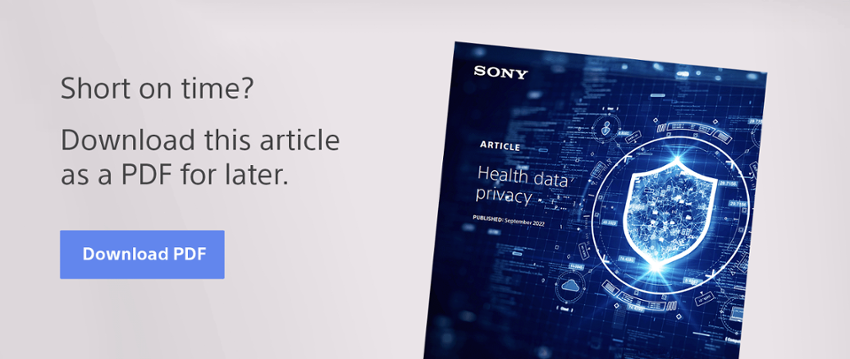At the heart of digital health
At the heart of digital health
The future of digital health is bright.
Real-time data, bidirectional data and contextual data can bring healthcare to new levels: more personalised, simplified and holistic. Whether for patients with chronic conditions or the elderly, digital health technologies such as remote patient monitoring devices can empower end users.
For clinical trials and other pharmaceutical studies, digitalisation in the form of remote monitoring offers a way to simplify adherence and retention. Large-scale health data analysis can also support public health research like never before.
Yet digital health must overcome a vital challenge: data privacy.
In short: digital health is built on health data, and patient health information is protected by law.
The longer story begins with understanding the overarching goal of all health care and research, whether digital or not. Namely, to improve health outcomes and help people lead longer, more dignified lives. It would only be counterproductive to achieve this while undermining patient confidentiality, privacy and autonomy.
So while health data offers an unprecedented opportunity to advance countless areas of health care and research – benefitting individuals and society as a whole – it all means very little if personal privacy isn’t protected. For any business looking to use or offer digital health solutions, it is essential to consider privacy from day one.
Unfortunately, while health data shouldn’t be handled lightly, health data privacy measures aren’t built into many existing consumer wearables or consumer smartphones that collect health data.

Cybersecurity breaches, ransomware attacks, data misuse. Threats to data privacy in healthcare are a growing concern, with a high cost to individuals and businesses alike.
In the United States, data breaches in the healthcare sector reached an all-time high in 2021. In fact, the healthcare sector faced the most ransomware attacks out of any sector, according to the Federal Bureau of Investigation’s 2021 Internet Crime Report. This trend shows no sign of abating. Of course, threats to health data privacy are not by definition malicious. But health data in the hands of unauthorised third parties is never in the interest of the end user.
On top of threats to individuals, cybersecurity breaches are incredibly costly for care providers. The downtime, lost customers and even a diminished reputation make healthcare data security a wise business decision as well. With more customers adopting digital health devices, providers have a responsibility to build trust with secure health data infrastructure. Not to mention, abide by national regulations.
Health services need secure digital health platforms that allow them to control their data entirely. Only then can they ensure compliance to their information security policy.
Regulation helps protect individual’s privacy, but it’s in the interest of care providers and digital health innovators too. Regulation of health data standardises data practices, enabling more effective data sharing and health research.
Protected health information (PHI) and personal identifiable information (PII) are already built into data protection laws around the world. This includes legislation about general personal data such as GDPR in the European Union, as well as specific healthcare information acts such as HIPAA in the United States.
Foreseeing the ground-breaking potential of digital health innovation, global and national institutions rush to create health data frameworks and innovation initiatives. All of them consider cybersecurity a top priority. Take for instance the policy recommendations from the Organisation for Economic Co-operation and Development (OECD). Their recent review, Health Data Governance for the Digital Age, puts cybersecurity in focus for their next reporting cycle.
For health care providers and digital health innovators, it is critical that they understand and comply with these regulations and handle the sensitive health data they are responsible for with the utmost care. For this to happen, health services need secure digital health platforms that allow them to control their data entirely. Only then can they ensure compliance to their information security policy.
Register and get a free copy of our white paper to learn more.
What does control over health data look like? The CIA triad guides the way for any digital health system or information security policy. Confidentiality, integrity and availability of the health data should be protected by any business responsible for health data, and is a crucial part of every secure IoT device, mHealth technology or digital health tool.
Only authorised users and processes should be able to access or modify data
The data is tamper-proof, including both accidental and intentional tampering.
Authorised users should be able to access the data whenever they need to.
mSafety doesn't only make digital health innovation more possible than ever. Developing a remote monitoring solution on mSafety makes health data privacy straightforward from day one. There is no need to patch privacy retroactively.
When building your health application on mSafety, you control the health data. Entirely. No third party, including Sony, will have access to the sensor data you collect. This is one of the many reasons that a solution developed on mSafety becomes an organic part of your healthcare service, not an accessory.
From hardware production to the customer backend, data security and privacy are built into the mSafety architecture. This makes it possible to ensure that application data from the wearable to the customer’s backend is end-to-end encrypted. But mSafety’s chain of trust doesn’t end there. The chain of trust includes:
Copyright 2025 Sony Network Communications Europe.